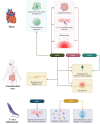Galectins in Protozoan Parasitic Diseases: Potential Applications in Diagnostics and Therapeutics
- PMID: 38067100
- PMCID: PMC10705098
- DOI: 10.3390/cells12232671
Galectins in Protozoan Parasitic Diseases: Potential Applications in Diagnostics and Therapeutics
Abstract
Neglected tropical diseases (NTDs) constitute a group of diseases that generally develop in tropical or subtropical climatic conditions and are related to poverty. Within the spectrum of NTDs, diseases caused by protozoa such as malaria, Chagas disease, and leishmaniasis exhibit elevated mortality rates, thereby constituting a substantial public health concern. Beyond their protozoan etiology, these NTDs share other similarities, such as the challenge of control and the lack of affordable, safe, and effective drugs. In view of the above, the need to explore novel diagnostic predictors and therapeutic targets for the treatment of these parasitic diseases is evident. In this context, galectins are attractive because they are a set of lectins bound to β-galactosides that play key roles in a variety of cellular processes, including host-parasite interaction such as adhesion and entry of parasites into the host cells, and participate in antiparasitic immunity in either a stimulatory or inhibitory manner, especially the galectins-1, -2, -3, and -9. These functions bestow upon galectins significant therapeutic prospects in the context of managing and diagnosing NTDs. Thus, the present review aims to elucidate the potential role of galectins in the diagnosis and treatment of malaria, leishmaniasis, and Chagas disease.
Keywords: Chagas disease; galectins; leishmaniasis; malaria.
Conflict of interest statement
The authors declare no conflict of interest.
Figures




Similar articles
-
Dual Inhibition of Parasitic Targets: A Valuable Strategy to Treat Malaria and Neglected Tropical Diseases.Curr Med Chem. 2022;29(17):2952-2978. doi: 10.2174/0929867328666210810125309. Curr Med Chem. 2022. PMID: 34375176 Review.
-
Exploring N-myristoyltransferase as a promising drug target against parasitic neglected tropical diseases.Eur J Med Chem. 2023 Oct 5;258:115550. doi: 10.1016/j.ejmech.2023.115550. Epub 2023 Jun 8. Eur J Med Chem. 2023. PMID: 37336067 Review.
-
Flavonoids as efficient scaffolds: Recent trends for malaria, leishmaniasis, Chagas disease, and dengue.Phytother Res. 2019 Oct;33(10):2473-2517. doi: 10.1002/ptr.6383. Epub 2019 Aug 23. Phytother Res. 2019. PMID: 31441148 Review.
-
The roles of galectins in parasitic infections.Acta Trop. 2018 Jan;177:97-104. doi: 10.1016/j.actatropica.2017.09.027. Epub 2017 Oct 3. Acta Trop. 2018. PMID: 28986248 Free PMC article. Review.
-
Metallodrugs for the Treatment of Trypanosomatid Diseases: Recent Advances and New Insights.Curr Pharm Des. 2021;27(15):1763-1789. doi: 10.2174/1381612826666201113104633. Curr Pharm Des. 2021. PMID: 33185155
Cited by
-
The expression of immune response genes in patients with chronic Chagas disease is shifted toward the levels observed in healthy subjects as a result of treatment with Benznidazole.Front Cell Infect Microbiol. 2024 Jul 23;14:1439714. doi: 10.3389/fcimb.2024.1439714. eCollection 2024. Front Cell Infect Microbiol. 2024. PMID: 39119291 Free PMC article.
References
-
- Doenças Tropicais Negligenciadas: OPAS Pede Fim dos Atrasos no Tratamento Nas Américas—OPAS/OMS | Organização Pan-Americana da Saúde. [(accessed on 11 July 2023)]. Available online: www.paho.org.
Publication types
MeSH terms
Substances
Grants and funding
LinkOut - more resources
Full Text Sources
Medical

